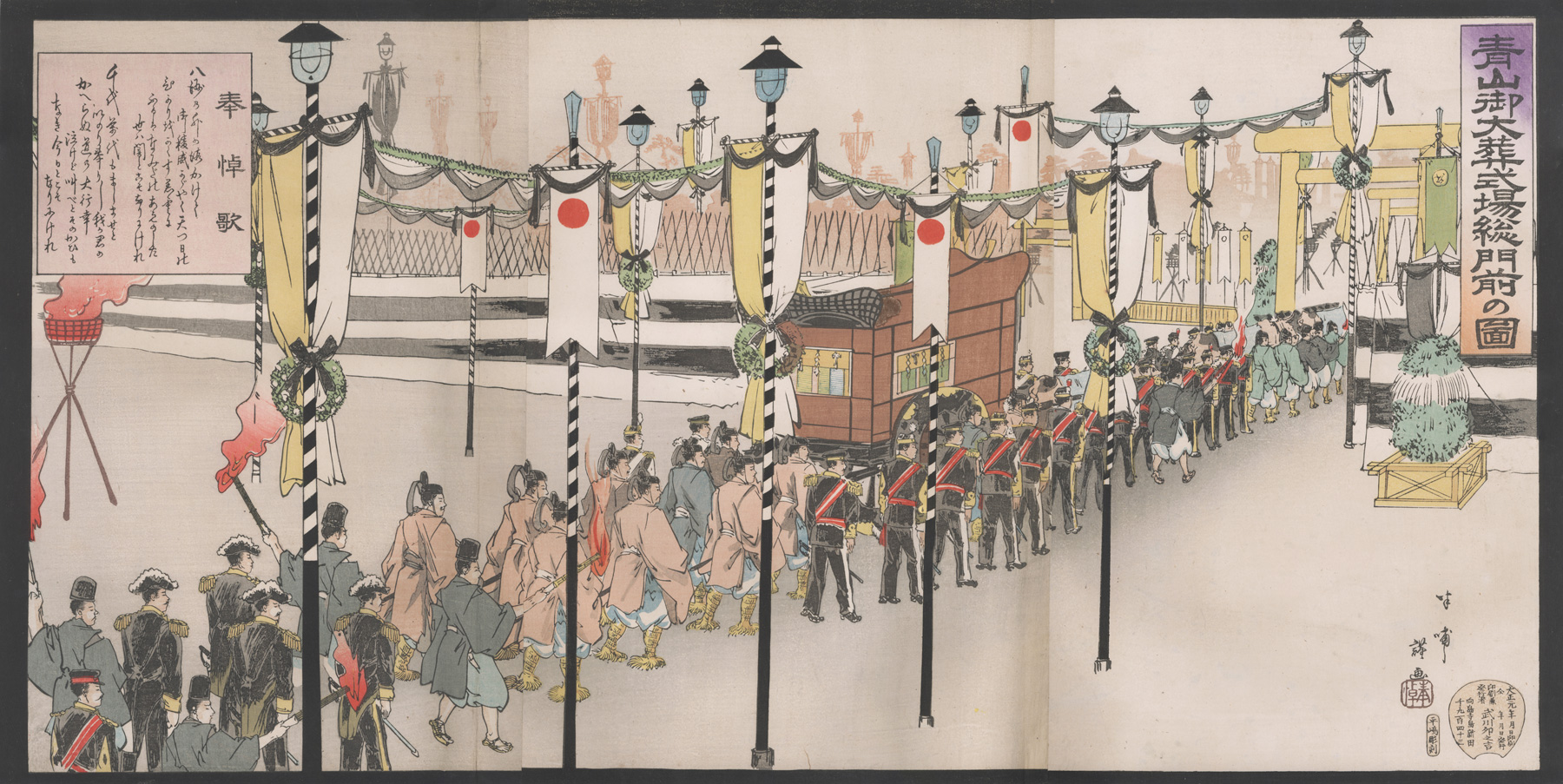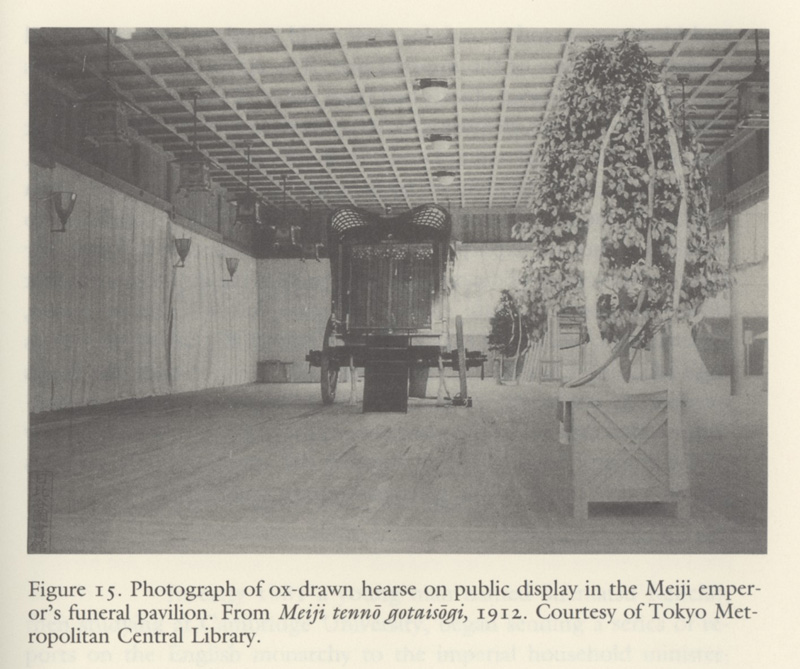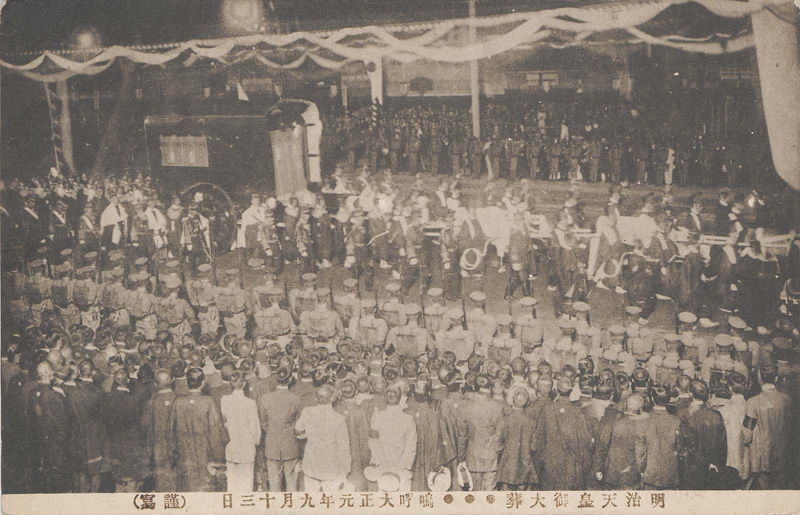About This Print
Bordered in black, this is one of two prints (the other being the hexaptych Illustration of His Imperial Majesty's Funeral Outside Nijūbashi) created by the artist picturing the September 13, 1912 evening funeral procession for Emperor Meiji from the Imperial Palace to the Aoyama military parade grounds. While this print depicts the procession entering the parade grounds the hexaptych pictures the procession just after its departure from the Imperial Palace and passage over Nijūbashi.The hearse, roofed in Chinese style like the one used at thefuneral of Dowager Empress Eishō, was lacquered black all over and decoratedwith more than 3,000 metal ornaments, the whole weighing more than threetons. The hearse was drawn by fivespecially chosen oxen. At eight, when itwas already quite dark, the solemn procession began to move slowly from thecourt entrance, illuminated by lanterns. The procession was headed by the former chief chamberlain, TokudaijiSanetsune, Chamberlain Hōjō Ujiyasu, and Master of the Horse Fujinami Kototada,dressed in formal robes of mourning and wearing swords; they and other noblespulled the ropes of the funeral carriage. Two nobles who had personally servedthe late emperor walked on either side of the carriage, holding aloft torchesto illuminate the way.
The funeral cortege was led by two offers bearing torches. They were followed by some 300 men carryingtorches, drums, bells, white flags, yellow flags, quivers, bows, shields,halberds, imperial pennants decorated with the sun and moon, and chestscontaining articles of war and of Shintō worship. These men, in rows of two or three, served asan advanced guard for the hearse. Otherofficials followed, and the hearse itself was preceded by fifty Yase no dōji [men from Yase who werecalled “doji" or boys because they did not shave their front locks, whotraditionally served as palanquin bearers for the imperial family] in tworanks. Officials, includingchamberlains, who had personally served the late emperor walked close to thehearse and directly behind them came other chamberlains.
The hearse arrived at 10:56 P.M. at the Aoyama funeral hall. Officers representing the emperor, empress,and empress dowager went out to meet the hearse which, after passing throughthe first and second tori, was taken into a curtained enclosure in front of thefuneral hall. Here the oxen werereleased from the shafts of the hearse, and the coffin was carried into thefuneral hall.... The services ended at 12:45 in the morning of September 14.
Overview of Funeral Ceremonies
Source: "The Funerals of the Japanese Emperors," Francois Mace, appearing in the Nanzan Bulletin 13, 1989, p. 26 - 29. https://nirc.nanzan-u.ac.jp/nfile/1853
On July 30,1912,at 12:43 in the morning, the Emperorof Japan died. With the Emperor’s death the Meiji era came to an end and a newera, the first year of the Taisho era, began. On August 13,1912,the body of the deceased sovereignwas transferred to the hinkyū 殯广呂,the “palace of temporary interment,”which had been prepared in the central pavilion of the palace. Every ten days,for a period of 50 days, offerings of food and textiles were placed before thecoffin and eulogies delivered. On August 29,thedeceased was given the posthumous name of Emperor Meiji, under which name hehas been known from then on. On September 4,thediplomatic corps were invited to pay a visit to the pavilion of temporaryinterment. As dean of the diplomatic corps the ambassador of Great Britaindeposited a silver crown. On September 13,onemonth and a half after the demise, the memorial tablet carrying the name of theEmperor was placed in his private chambers, while outside the funeral was beingheld on the military terrain of Aoyama 肯山 . At 7:00 in the evening the bodywas carried from the palace and placed in a gold and lacquer decorated chariotdrawn by five oxen. The mortuary parade consisted of three hundred personscarrying torches, drums, gongs, banners, bows, shields, and lances. Theprocession was joined by the army band and by a group of youths from Yase 八瀨,a village situated to the northeastof the ancient capital, Kyoto. The streets had been covered with sand anddecorated with white-and-black cloths and lanterns. At 10 o'clock in theevening the procession arrived at the site of the ceremony after having passedunder two gates, torii 鳥居,identicalto those found at the entrance of Shinto shrines. At 11:15 the last rites,salutes, offerings, and funerary eulogies started. It was during this samenight that General Nogi 乃木, victorover the Russians in 1904 and national hero, and his wife committed ritualsuicide, in order to accompany the Emperor in death. A sanctuary, consecratedto Emperor Meiji and his spouse, was later erected on the site of the funeraryceremonies: the Meiji Jingu, now in the heart of Tokyo. On September 14,at 1:00 in the morning, two specialtrains transported the mortuary convoy to Kyoto.At 7:00 in the evening the body was placed in a sarcophagus, surrounded byhaniwa 埴 輪(terra cotta figurines) mounted on a cylinder, inside a burial mound situatedto the south of the ancient capital. On the morning of the 15th, a lastfunerary ceremony took place in front of this mound.
One year later, the memorial tablet inscribed with the name of the deceased Emperor was placed together with the tablets of his ancestors. In November of the same year, the new Emperor celebrated the solemn partaking of the first fruits, a ceremony which since ancient times constituted an obligatory complement to to the enthronement rites.
Such were the ceremonies held for the Emperor who had succeeded in modernizing Japan so as to safeguard its independence.
Song of Mourning
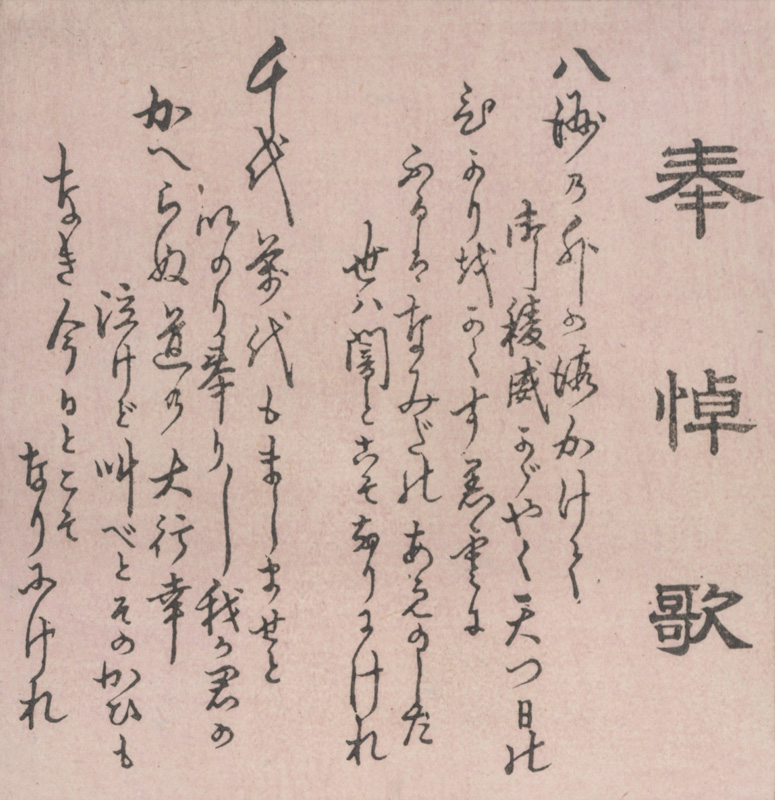 click on image to enlarge | Sources: http://rasensuisha.cocolog-nifty.com/kingetsureikou/2014/11/index.html and http://tokyosigaku.jugem.jp/?eid=277 奉悼歌 Song of Mourning. The music was composed by Akataro Shimazaki 島崎赤太郎 (1874-1933), professor at The Tokyo Music School 東京音楽学校, with lyrics composed by Motoori Toyokai 本居豊頴 (1838-1913), tanka poet and scholar of Japanese literature. 一、八洲の外の海かけて 御稜威輝く天津日の 光を隠す黒雲に 降るは涙の天の下 世は暗(やみ)とこそなりにけれ 二、千代萬代も在ませと 祈り奉(まつ)りし我君よ 帰らぬ途の おほ行幸(みゆき) 泣けどさけべどその甲斐も なき今日とこそなりにけれ |
Print Details
| IHL Catalog | #1683 |
| Title or Description | Illustration of the Main Gate at Aoyama During the Imperial Funeral Ceremony Aoyama Gotaisō shikijō sōmonzen no zu 青山御大葬式場総門前の図 |
| Series | |
| Artist | Hanpo (active 1904-1912) |
| Signature |  半哺謹画 半哺謹画Hanpo kinga (respectfully drawn) |
| Seal of the Artist | 奉悼 hōtō seal |
| Publication Date | 1912 Meiji 45/Taishō 1 (大正元年 as shown in publisher's seal below) |
| Publisher | 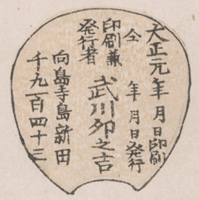 [firm name: Unosuke] 向島寺島新田 千九百四十三 Mukōjima Terashimashinden 1943 [Marks: pub. ref. 522; seal not shown] |
| Carver | 平嶋彫刻 Hirashima or Hirajima chōkoku  |
| Printer | |
| Impression | excellent |
| Colors | excellent |
| Condition | good - three sheets joined together and backed with heavy album paper; two vertical folds; light soiling |
| Genre | nishiki-e; |
| Miscellaneous | |
| Format | horizontal ōban triptych |
| H x W Paper | 13 7/8 x 28 1/8 in. (35.2 x 71.4 cm) |
| H x W Image | 13 7/8 x 28 1/8 in. (35.2 x 71.4 cm) |
| Literature | |
| Collections This Print | Museum of Fine Arts, Boston 2000.2888a-c; Tokyo Digital Museum 99200043, 99200045 |


